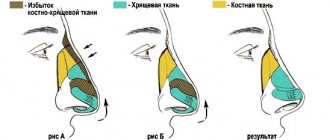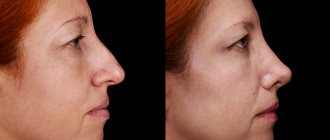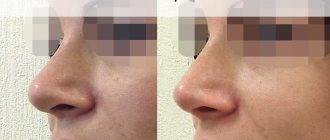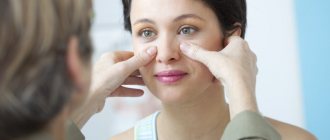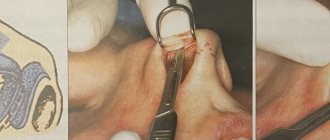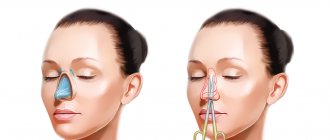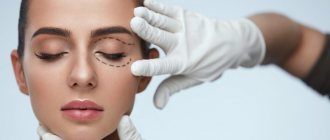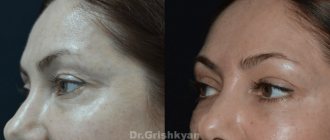The postoperative period after rhinoplasty, including some unpleasant but inevitable consequences, lasts up to 3 months. At the same time, the most important period of rehabilitation is the first weeks when the patient wears a cast. An experienced surgeon prefers plaster after rhinoplasty - it performs all the important functions that a “new” nose needs.
As you know, swelling of the face, especially the eyes and cheeks, can last up to several months - this is due to damage to the blood vessels in the nasal cavity. However, the nose itself does not experience as much swelling. This effect is achieved by plaster - it inhibits swelling. After removing it, of course, the shape of the nose will be far from the desired result, since swelling will still be present, albeit in a small amount. That is why surgeons recommend assessing the final result of the operation no earlier than after 6-9 months, when the bone tissue has finished forming and the swelling has completely subsided.
Gypsum also plays another important role - it prevents mechanical damage. Even a small accidental blow can cause deformation, since the tissues immediately after the operation are still very soft. The plaster “holds” its new shape until the doctor allows it to be removed.
It doesn’t matter whether you wear a full-fledged cast with tampons-turundas or a splint for light protection - it is strictly forbidden to remove them before a doctor’s prescription, regardless of how long you will have to wear the cast after rhinoplasty. In addition, it is undesirable to wet, squeeze, hit or even sneeze - any impact on the nose can damage it.
Doctors also prohibit the following:
- Wear glasses for 4 weeks after rhinoplasty;
- If possible, eat only liquid foods;
- Avoid swimming pools, baths and excess liquid on the face;
- Sleep with your head elevated on the pillow to prevent excessive swelling.
How many days does it take to remove the cast after rhinoplasty?
Of course, every patient who has undergone nose correction surgery is concerned with the question of how many days after rhinoplasty the plaster is removed. Of course, because it causes so much inconvenience! With it, you will not be able to go outside, return to work or physical activity. Particular problems arise with breathing - due to tampons in the nose, you will only have to breathe through your mouth. At the same time, they also perform an important function: they remove excessive bleeding (a normal reaction of the body) and prevent the septum from deformation.
On what day should tampons be removed after rhinoplasty? As a rule, you can get rid of turundas in the nose within a day, maximum 3 days after surgery. Until this point, the patient suffers from difficulty breathing and other related difficulties.
On what day is the cast removed after rhinoplasty? Plaster is a more serious protection, which is why it is worn a little longer. After 7-10 days, the plaster is removed, but swelling of the nose persists for the next few weeks.
The result of rhinoplasty cannot be seen immediately after the cast is removed. But some things can be appreciated immediately. For example, a fundamental change in shape: if before rhinoplasty the nose was long - an approximate degree of shortening, if it had a hump - its absence. Details emerge over the course of 1-2 months and the nose is finally formed by 8-10 months.
But it’s difficult to wait and not worry, so let’s figure out what is a complication after rhinoplasty and what is the norm.
Plastic surgeon Danila Aleksandrovich Kuzin tells:
1. Itching after rhinoplasty
. The very first complaint a plastic surgeon encounters is that the nose itches under the cast. It's okay - this is a sign of healing.
Small pustules may appear on the nose under the plaster cast/plasters, especially if the skin is porous and oily. After removing the plaster, the pustules open up, they need to be wiped with an alcohol wipe, and within a day or two the inflammation goes away.
As a rule, the plaster cast is removed 7-10 days after rhinoplasty. By this time, some of the swelling has already gone down, the plaster begins to come off, the skin begins to breathe, and this process is also accompanied by itching.
There are no clear and obvious signs of a bedsore under the plaster cast. Only the experience of the surgeon can predict the development of such a complication.
2. Complaints of pain after rhinoplasty
are rare. There may be pain during examination: if you touch the nose, squeeze out the swelling, check the position of the bones after osteotomy.
In extremely sensitive patients who react to changes in pressure and other fluctuations in weather conditions, aching and aching sensations in the nose may appear for some time, especially with swelling.
Pulsation, pain, and tension when tilting the head are also normal, since when tilting, the blood flow to the nose increases, and the outflow in this area does not yet work at full strength. Sudden blood flow may bring a sensation of pulsation or pressure.
3. Asymmetry after rhinoplasty
.
Patients begin to examine themselves already in a cast, carefully studying the position of the nostrils, their shape, and size. If the nostrils are initially symmetrical, then (excluding some force majeure situations) they will remain so after nose surgery.
If asymmetry already existed, then the nostrils will most likely remain asymmetrical. It is better for plastic surgeons to cover this point before surgery. Because after a nose job, the patient will immediately notice an even greater difference in the shape or size of the nostrils, emphasized by swelling. You need to be prepared for this situation.
4. The most common complaint in the first month after rhinoplasty is that a hump remains
. Swelling in the area of the bridge of the nose can imitate a hump, and the patient thinks that it has not been completely removed. It is easy to demonstrate the absence of a hump: the plastic surgeon pushes out the swelling, applying additional bandages or strips, and the patient sees that the problem is dense swelling that changes the shape of the nose.
5. Dryness and crusts after rhinoplasty
. If before the nose job there were problems with breathing, if the condition of the mucous membrane was not ideal (mucus and crusts often appeared), then after the operation this may continue. If this is a new complaint, then we recommend moisturizing drops or oil to moisturize the mucous membrane.
Complaints may also arise from scratching and difficulties with cleaning.
nasal passages. This is often due to inaccurate implementation of postoperative recommendations. If care is performed correctly, all this will go away over time.
6. Smell in the nose after rhinoplasty
not typical and not normal. Ideally, there should be no foreign or putrid odor. The smell may be associated with discharge from the maxillary sinuses.
All biological fluids of the body have their own smell, but immediately after the operation the nose is thoroughly cleaned, turundas are placed so that blood clots have nowhere to accumulate, and in the postoperative period the patient must thoroughly and regularly rinse the nose. If blood clots are observed longer than usual, the patient is invited to be examined more often and the surgeon monitors the patency of the nasal passages, adjusting nasal care.
If an implant is installed
(silicone, Medpor or PTFE), it is extremely important to monitor whether it has moved or whether its section has come out. The smell in this case may be a signal for the surgeon to carefully check the areas in which the implant is located. Check the integrity of the covers over the implant, whether there are bedsores, fluid accumulation or signs of inflammation.
7. Clicking, crunching when installing the implant
. Before nose surgery, the future patient does not examine himself as carefully as after. Therefore, the mobility of the nose can be a revelation for him. In fact, there is nothing to worry about - there must be a certain amount of play; the implant cannot stand tightly. Also, any person can experience clicking if the nose is displaced.
The nose is a mobile structure. But there should not be pathological mobility: if the implant can be moved more than a couple of millimeters, this is a reason to contact a surgeon. Much depends on the installation and type of implant, but contouring and excessive mobility will be abnormal.
8. complaints after rhinoplasty
can occur both after surgery and after 3-4 months.
Breathing does not return to normal immediately, especially when affecting the septum and nasal turbinates. It is completely normal if, within 2-3 months after surgery, the nose periodically becomes blocked, it swells, breathing becomes difficult, the nostrils breathe differently - one is better, the other is worse. Over time this will happen less and less.
Sometimes it’s the other way around: at the beginning everything is fine, but after 3-4 months the nose suddenly becomes stuffy. Usually there are reasons - a runny nose, a cold, a change in climate, a change in the usual room, air conditioning, inflammation. This is also normal: temporarily after surgery, the mucous membrane reacts more sensitively to internal and external irritations.
To communicate with patients who have undergone rhinoplasty, come to our forum, Rhinoplasty
Splint after rhinoplasty - an alternative to plaster
Some surgeons prefer to maintain the shape of the operated nose not with plaster, but with a medical splint - a bandage that is strong enough and also protects from damage. To the question “How long do you wear a splint on the nose after rhinoplasty?” surgeons answer unequivocally: the same as plaster.
Despite all the inconveniences, it is necessary to wear a cast, tampons and a splint. By taking all protective measures and following all the requirements, you can achieve the desired result - a perfect nose that suits your face shape.
How long does the recovery period last?
If the hump has been removed, recovery after rhinoplasty will take about six months. For the first 10 days the patient wears a splint. In the case where the tip of the nose has been corrected, the recovery period after rhinoplasty will last approximately the same, but the splint will be removed after a week. In addition to the plaster, for the first two days the patient wears turundas, which are designed to prevent compression of swollen tissues. Turundas also prevent excess liquid from accumulating. During this period, breathing through the nose is very difficult, so you have to experience slight discomfort.
The specialist who is seeing the patient can tell exactly how long it takes to recover after rhinoplasty. Some people experience full recovery within 2 months, while others take 6 months. It all depends on the characteristics of the human body and compliance with care recommendations.
Preparing for surgery
• Before surgery, you must have a personal consultation with a plastic surgeon. After a comprehensive discussion with the client about the future operation, the surgeon will determine its procedure and provide detailed instructions. • 1 week before the operation, you must bring (send) test results and a doctor’s report to our clinic. It is also possible to take all tests and be examined in our clinic 1 day before the operation. But, it is necessary to take into account that if the test results do not correspond to the norm, the operation will be postponed. • You must stop taking blood thinning medications 3 weeks before surgery. • 2-3 weeks before surgery, the client should not have suffered an acute or inflammatory disease (eg acute respiratory infections, influenza), and also smokers should limit smoking, since smoking greatly slows down the recovery process. • A prerequisite for this operation is good health, exclusion of pregnancy and breastfeeding. • You must come to the operation on an empty stomach, i.e. 8 hours before the operation you should not drink, eat, smoke, it is also recommended to wash your hair and not apply makeup to your face. • After surgery, the client remains in the hospital for 1 night.
What is rhinoplasty and what are the indications for surgery?
Nasal defects can be either acquired (injury) or congenital. Often, with the help of rhinoplasty surgery, it is possible to solve not only aesthetic, but also functional problems (nasal breathing). Rhinoplasty is a plastic surgery aimed at changing the shape and size of the nose, performed in two ways - open and closed. The most common method is closed rhinoplasty. This technique does not leave visible scars on the skin. Open rhinoplasty involves an incision in the columella and inside each nostril. The surgical method is chosen by the plastic surgeon during the consultation, taking into account the individual characteristics and wishes of each client.
The final result, its preservation and maintenance
The fully formed result of nose surgery will be visible in 6-12 months. At earlier stages of rehabilitation after rhinoplasty, defects (overcorrection or insufficient correction of the nose), if they occurred, become visible. They can be corrected with repeated surgery. According to experts, the probability of revision rhinoplasty is approximately 15%. The result of surgical correction of the shape of the nose, most often, remains forever, less often - unchanged for several decades. You can independently maintain this result in two ways - follow all the doctor’s recommendations for the rehabilitation period and protect your nose and face from injury.
Contraindications for surgery:
• Incomplete formation of the facial skeleton (up to 18 years of age) • Diabetes mellitus • Blood clotting diseases • Oncological, inflammatory, infectious diseases
For minor patients, rhinoplasty surgery is not suitable, since it is performed only after the cessation of growth and puberty. Surgery performed at an earlier age may impair the patient's development and growth.
The optimal age for rhinoplasty is from 18 to 35 years, but these limits are very arbitrary, since everything depends on the scale of the surgical intervention and on the type and quality of the skin on the nose.
From the point of view of restorative processes, sufficient flexibility and elasticity of the soft tissues allows larger operations to be performed, as well as reducing the risk of excessive scarring and thickening of tissues, which can negatively affect the final shape of the nose.
